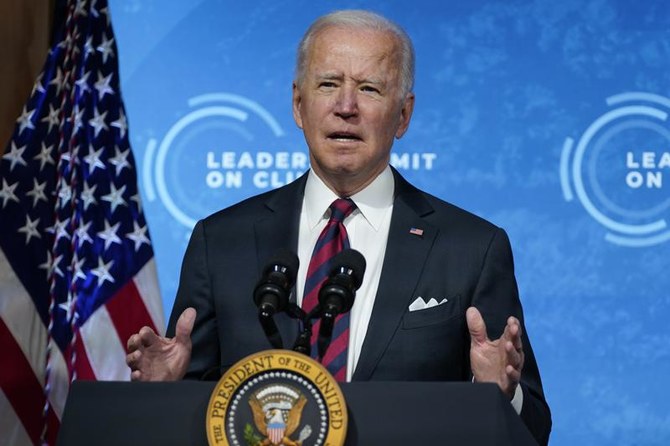Rich nations continue to shun climate funding commitments

https://arab.news/nyqtc
In the end, the much-hyped leaders’ climate summit, hosted by US President Joe Biden last week, ended pretty much the same way every multilateral climate meet has in the past decade or so: Claiming victory and a “renewed vigor” to save the planet from the man-made disaster that it is currently hurtling toward us.
It was certainly welcome to see the US, the world’s second-largest greenhouse gas emitter and by far the largest on a per capita basis, take this initiative after a four-year-long hubris under the Trump administration, which saw the country exit the Paris climate agreement. Biden did the right thing by promptly taking the US back into the agreement and then getting the leaders of the world’s 40 biggest emitting nations around a virtual table to discuss the progress made since the Paris meeting in December 2015. He urged each nation to set more aggressive targets in cutting emissions, which would then be presented at the delayed COP26 meeting in Glasgow in November.
Fortunately, the meeting’s agenda also included the contentious issue of climate finance. This is one of the key pathways to ensuring the battle to cut emissions and curb the impact of climate change around the world is successful, especially in the poor and more vulnerable countries. The US pledged $5.7 billion in climate finance aid annually by 2024 to help developing countries deal with climate change. But this falls woefully short of what is needed. More than a decade ago, the developed world pledged to provide $100 billion each year to developing nations to help them deal with climate change, as well as curb their own emissions. However, this pledge has never been fulfilled, even as the cost of climate change for many poor, notably small-island, states has ballooned due to the high frequency of severe climate incidents taking place each year all around the world.
Various studies have shown how far behind the West is in meeting its commitments. What’s worse is that, not only have the rich nations consistently failed to live up to their word, but they have also resorted to clever accounting practices and even outright fudges. For instance, most developed countries have begun counting several unrelated and prior commitments, such as existing bilateral assistance — committed for diverse purposes such as health or education — or even loans, whether from government to government, multilateral or even private sector loans for projects that are totally disconnected from climate change and whose implementation will not have any impact on climate change commitments.
So blatant are these fudges and so far behind is the rich world in meeting its commitment that even the UN climate chief Patricia Espinosa was forced to take up the issue on the same day the Biden climate meet began. “We need clear signals that commitments made by developed countries to developing countries will become a reality. We still don’t have those $100 billion with clarity on the table,” said the UN official in an unusually frank and open lashing of the leaders of the rich world.
Not only have they consistently failed to live up to their word, but they have also resorted to clever accounting practices and even outright fudges
Ranvir Nayar
Developing countries need fiscal assistance for two distinct purposes: To deploy new technology to cut their own emissions and for the adaptation and mitigation of climate change impact. Though some developed world leaders have been asking why they need to pay for the rest of the world, the logic is pretty straightforward. Climate change is overwhelmingly due to the mindless industrialization and consumption that Western societies have been indulging in for the past two centuries. Not just that, even today, rich countries account for a very large share of greenhouse gas emissions.
According to the International Energy Agency, in 2018, 12 rich countries accounted for 35 percent of global carbon dioxide emissions. The disproportionate role of the rich world becomes more evident if taken on a per capita basis, which is the sole fair measure of each country’s responsibility for climate change. Australia’s 2018 per capita carbon dioxide emissions were 16.88 tons and the US’ 16.16 tons. China, which accounts for 25 percent of global emissions, fades in comparison on a per capita basis, at 6.86 tons. India produced an insignificant 1.84 tons of carbon dioxide per capita.
Back in 2015, the developing countries, led by India, sought $2 trillion in finance for both cutting their emissions and also adapting to climate change and mitigating its impact on their populations and economies. Since then, the rich nations have kicked the can down the road, reluctant to even raise it at multilateral forums. They cannot use last year’s economic meltdown caused by the coronavirus pandemic as an excuse to shun their responsibility.
As the global community heads towards COP26, it is crucial that developed nations stop toying with the developing nations and meet their commitments. They would do well to remember that, without global cooperation and each country being equipped with the required technology and finance, the Earth will continue to hurtle rapidly toward a complete climate disaster. This will affect people all over the planet, as could be seen in the large number of severe weather events that occurred across the developed world last year, from the US to Serbia and from Canada to Australia.
• Ranvir S. Nayar is managing editor of Media India Group.









































